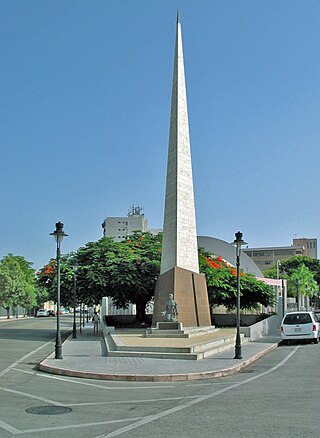
Teatro La Perla is a historic theater in the city of Ponce, Puerto Rico. Inaugurated in 1864, it is the second oldest theater of its kind in Puerto Rico, but "the largest and most historic in the Spanish-speaking Caribbean." The theater was named La Perla in honor of the Virgin of Montserrat, known as "The Pearl of the Mediterranean." It is located in barrio Tercero, in the Ponce Historic Zone.
Julián H. Villodas was Mayor of Ponce, Puerto Rico, from 1 January 1827 – 31 December 1830. He performed as a teniente a guerra.

José Ortiz de la Renta was Mayor of Ponce, Puerto Rico, from 1812 to 1814, 1815 to 1816, 1820 to 1821, 1823 to 1826, 1837 to 1838, 1842 to 1843, 1843 to 1844, and in 1846. He has the distinction of having held the office of mayor of Ponce the most — eight times. He was an hacendado.

Parque de la Abolición is a city park in Barrio Cuarto, Ponce, Puerto Rico. It was the first park in the Caribbean to commemorate the abolition of slavery. It was built in 1874 and renovated in 1956.

Plaza Degetau, formally Plaza Federico Degetau, is the larger of two plazas at Plaza Las Delicias, the main city square in the city of Ponce, Puerto Rico. The other plaza is named Plaza Muñoz Rivera and is located north of Plaza Degetau. The square is notable for its fountains and for the various monuments it contains. The historic Parque de Bombas and Ponce Cathedral buildings are located bordering the north side of this plaza. The square is the center of the Ponce Historic Zone, and it is flanked by the historic Ponce City Hall to the south, the cathedral and historic firehouse to the north, the NRHP-listed Banco Crédito y Ahorro Ponceño and Banco de Ponce buildings to the east, and the Armstrong-Poventud Residence to the west. The square dates back to the early Spanish settlement in Ponce of 1670. It is the main tourist attraction of the city, receiving about a quarter of a million visitors per year.

The Monumento a la abolición de la esclavitud is a monument at Parque de la Abolición in Barrio Cuarto in Ponce, Puerto Rico, dedicated to the abolition of slavery in Puerto Rico in 1873. It is the only monument in the Caribbean dedicated as a remembrance to the abolition of slavery. The monument consists of an obelisk and a statue called El Hombre Redimido.

Concha Acústica de Ponce is an open-air music and performing arts amphitheater venue in Barrio Cuarto, Ponce, Puerto Rico, owned and managed by the Ponce Municipal Government. It is located on the grounds of Parque de la Abolición. The open-air auditorium-amphitheater is used primarily for cultural events. It is open from Monday through Friday, 8:00AM to 4:30PM. Concha Acústica, as it is known today (2017), is the result of a 1956 redesign that also included the adjacent Monumento a la abolición de la esclavitud. The original design was augmented by this 1956 redesign/renovation by Francisco Porrata-Doría (1890–1971).
Alejandro Ordóñez was Mayor of Ponce, Puerto Rico, from 3 January 1816 to 31 December 1818. He was a teniente justicia mayor.
José Mirelis was Mayor of Ponce, Puerto Rico, from 1 May 1880 to 31 January 1881. He was a Spanish soldier with the rank of colonel.
Francisco Carreras was Mayor of Ponce, Puerto Rico, from 1 January 1866 to 31 August 1866.
Esteban Vidal was Mayor of Ponce, Puerto Rico, from 1 July 1849 to 30 September 1849.
José María Quesada was Mayor of Ponce, Puerto Rico, from 1 October 1848 to 31 December 1848.
Demetrio Santaella was Mayor of Ponce, Puerto Rico, from 22 January 1867 to 31 December 1868.
Luis Alvarado y González was Mayor of Ponce, Puerto Rico, from 11 May 1896 to 28 March 1897. He was the commanding officer in town installed by the military government in Puerto Rico at the time (1896).
Carlos Cabrera y Martínez was interim Mayor of Ponce, Puerto Rico, from 1 November 1866 to 19 December 1866. He was interim mayor, together with Francisco Romero, and both performed as interim corregidors until Colonel Enrique O'Neil became the appointed corregidor on 20 December 1866 for the remainder of that year and into 1867.
Tomás Pérez Guerra was Mayor of Ponce, Puerto Rico, from 1 January 1826 to 31 December 1826.
Alejandro Albizu was an interim corregidor Mayor of Ponce, Puerto Rico, from when interim corregidor Francisco Arce y Romero terminated his mayoral duties around March 1872. He mayored the municipality of Ponce until 26 September 1872.
Miguel Arribas was Mayor of Ponce, Puerto Rico, from 28 July 1871 to 31 December 1871.
Francisco Olazarra was a corregidor Mayor of Ponce, Puerto Rico, from 23 June 1865 to 31 December 1865








